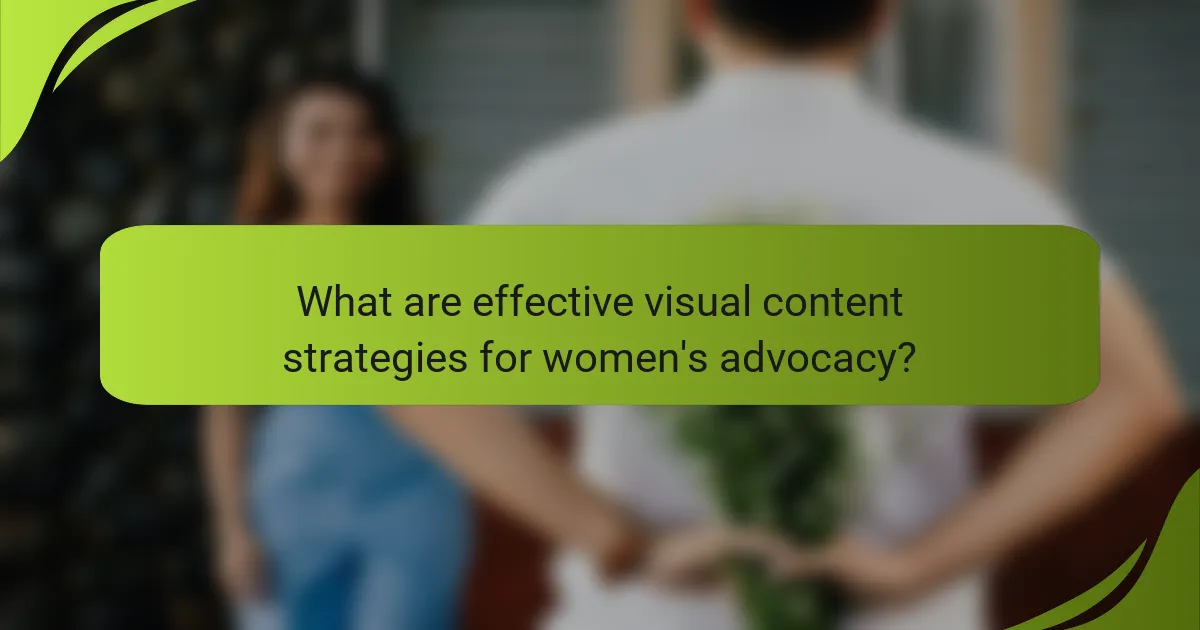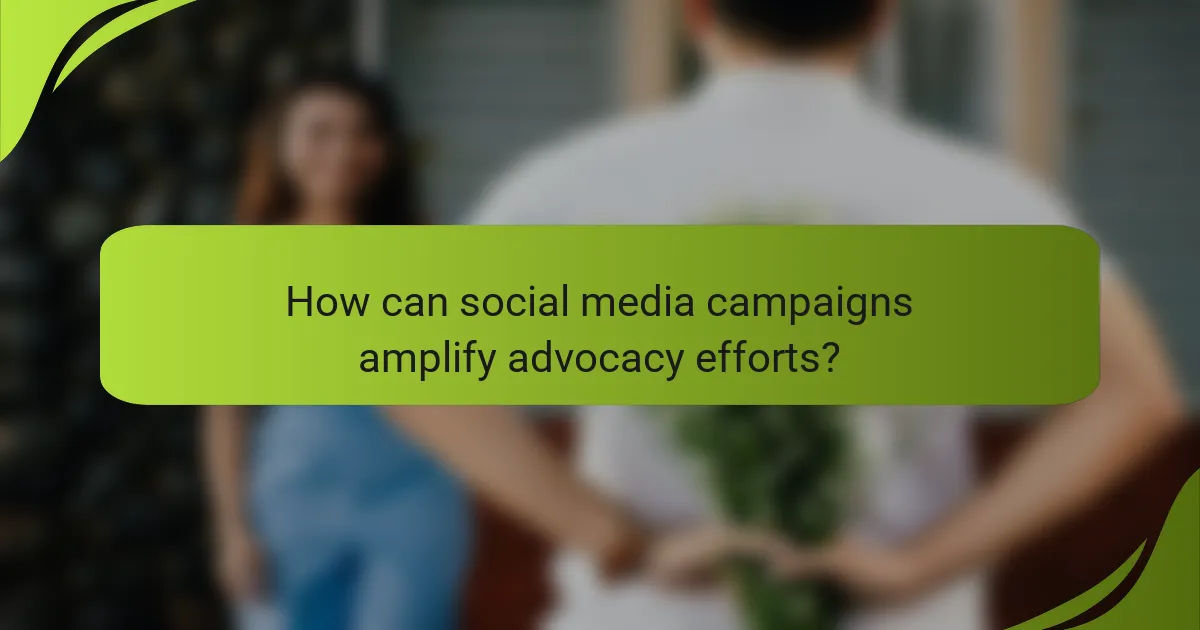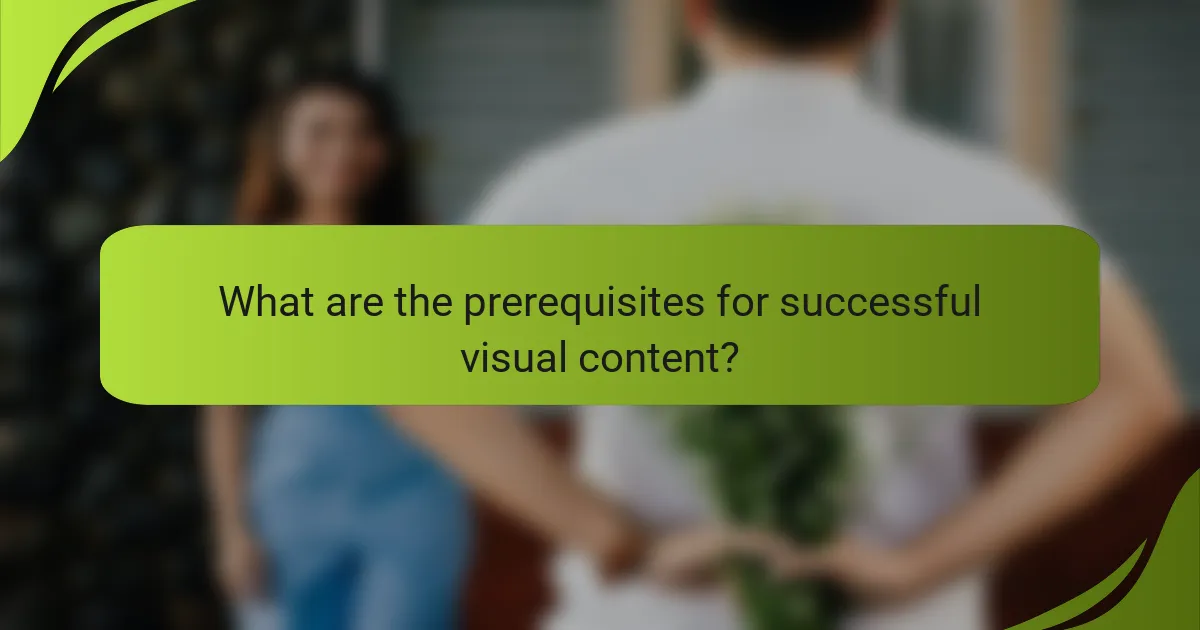Effective visual content strategies play a crucial role in women’s advocacy by utilizing compelling graphics, videos, and interactive elements to engage and inform audiences. These strategies not only raise awareness but also foster emotional connections, making advocacy efforts more impactful. Infographics and video storytelling are particularly powerful tools, as they present complex information in an accessible format and evoke strong emotional responses, inspiring viewers to take action.

What are effective visual content strategies for women’s advocacy?
Effective visual content strategies for women’s advocacy include using compelling graphics, videos, and interactive elements to convey messages and engage audiences. These strategies help to raise awareness, foster emotional connections, and encourage participation in advocacy efforts.
Infographics for data representation
Infographics are powerful tools for presenting complex data in an easily digestible format. They combine visuals with key statistics to highlight important issues related to women’s rights, such as gender pay gaps or representation in leadership roles.
When creating infographics, focus on clarity and simplicity. Use a limited color palette and clear fonts to ensure readability. Aim for a balance of text and visuals, and consider including sources to enhance credibility.
Video storytelling for emotional impact
Video storytelling can evoke strong emotions and create a personal connection with viewers. By sharing real-life stories of women affected by various issues, advocates can humanize statistics and inspire action.
To maximize impact, keep videos concise, ideally under three minutes, and include a strong call to action at the end. Use high-quality visuals and sound to maintain viewer engagement, and consider subtitles for accessibility.
Social media campaigns for engagement
Social media campaigns are essential for reaching a broad audience and fostering community engagement. Platforms like Instagram, Facebook, and Twitter allow advocates to share visual content, promote events, and encourage discussions around women’s issues.
To create effective campaigns, use relevant hashtags to increase visibility and engage with followers through polls, questions, and user-generated content. Regularly analyze engagement metrics to refine strategies and improve outreach.
Interactive content for audience participation
Interactive content, such as quizzes, polls, and surveys, encourages audience participation and can enhance understanding of women’s advocacy issues. This type of content invites users to engage actively rather than passively consuming information.
When designing interactive elements, ensure they are user-friendly and relevant to your advocacy goals. Consider offering incentives, such as downloadable resources or entries into a giveaway, to motivate participation and share results to foster community involvement.

How can infographics enhance women’s advocacy?
Infographics can significantly enhance women’s advocacy by presenting complex information in a visually engaging and easily digestible format. They help convey important messages, statistics, and narratives that resonate with audiences, making advocacy efforts more impactful.
Visualizing statistics for clarity
Infographics transform statistics into visual stories, making them easier to understand and remember. By using charts, graphs, and icons, advocates can highlight key data points related to women’s issues, such as gender pay gaps or representation in leadership roles.
For example, a bar graph showing the percentage of women in various industries can quickly convey disparities. Aim for clarity by limiting the number of data points to the most relevant ones, ensuring that the visuals do not overwhelm the viewer.
Highlighting key issues in a digestible format
Infographics can distill complex issues into simple visuals that communicate essential information at a glance. This format allows advocates to break down topics like domestic violence or reproductive rights into easily understandable segments, making the information accessible to a broader audience.
Consider using bullet points or small icons to represent key facts or steps for action. For instance, an infographic might outline the steps to seek help for domestic abuse, using clear visuals to guide the viewer through the process. Keep the design clean and focused to maintain audience engagement.

What role does video storytelling play in advocacy?
Video storytelling is a powerful tool in advocacy, as it engages audiences emotionally and conveys messages effectively. By combining visuals, sound, and narrative, advocates can create compelling stories that resonate with viewers and inspire action.
Creating personal narratives to connect
Personal narratives allow advocates to share their unique experiences and perspectives, fostering a deeper connection with the audience. These stories can highlight individual struggles, triumphs, and the impact of advocacy efforts, making the cause more relatable and human.
To create effective personal narratives, focus on authenticity and vulnerability. Use simple language and relatable scenarios to draw viewers in. For example, a woman sharing her journey through a health crisis can illustrate the importance of access to healthcare, making the issue more tangible for viewers.
Documenting real-life experiences
Documenting real-life experiences through video can bring attention to pressing issues and highlight the realities faced by individuals in the community. This approach not only raises awareness but also encourages empathy and understanding among viewers.
Consider using interviews, testimonials, or on-the-ground footage to showcase diverse experiences. For instance, a series of short clips featuring women discussing their challenges in the workplace can effectively underscore the need for gender equality initiatives. Aim for a mix of emotional and factual content to maintain viewer engagement and drive home the message.

How can social media campaigns amplify advocacy efforts?
Social media campaigns can significantly enhance advocacy efforts by increasing visibility, fostering community engagement, and driving action. They allow organizations to reach a broader audience, share impactful stories, and mobilize support for women’s issues effectively.
Utilizing platforms like Instagram and Twitter
Platforms such as Instagram and Twitter are essential for visual storytelling and real-time communication. Instagram’s focus on images and videos allows advocates to create compelling content that resonates emotionally, while Twitter’s fast-paced environment enables quick updates and discussions around pressing issues.
To maximize impact, use high-quality visuals and concise messaging tailored to each platform’s audience. For example, Instagram posts should feature eye-catching graphics or infographics, while Twitter can utilize hashtags to join larger conversations and trends relevant to women’s advocacy.
Engaging influencers for broader reach
Collaborating with influencers can significantly expand the reach of advocacy campaigns. Influencers often have dedicated followings that trust their opinions, making them powerful allies in promoting women’s issues and initiatives.
When engaging influencers, choose those whose values align with your advocacy goals. Provide them with clear messaging and creative freedom to ensure authenticity. Consider micro-influencers as well; they may have smaller audiences but often boast higher engagement rates, making them effective partners for grassroots campaigns.

What are the prerequisites for successful visual content?
Successful visual content requires a clear understanding of your audience and well-defined advocacy goals. These prerequisites ensure that the visuals resonate with viewers and effectively communicate the intended message.
Understanding target audience demographics
Knowing your target audience demographics is crucial for creating impactful visual content. This includes factors such as age, gender, location, education level, and cultural background, which can influence how your message is perceived.
For example, visuals aimed at younger audiences may utilize vibrant colors and modern design elements, while content for older demographics might favor more traditional styles. Conducting surveys or using analytics tools can help gather relevant demographic data.
Setting clear advocacy goals
Establishing clear advocacy goals is essential for guiding your visual content strategy. These goals should be specific, measurable, achievable, relevant, and time-bound (SMART), ensuring that your visuals align with your overall mission.
For instance, if your goal is to raise awareness about women’s health issues, your visuals should focus on educational content that highlights key statistics and personal stories. Regularly reviewing and adjusting these goals based on feedback and outcomes can enhance effectiveness.

How to measure the effectiveness of visual content?
Measuring the effectiveness of visual content involves analyzing various metrics that indicate how well the content engages and converts your audience. Key areas to focus on include engagement metrics and conversion rates, which provide insights into audience interaction and the impact on advocacy goals.
Analyzing engagement metrics
Engagement metrics reflect how users interact with your visual content, including likes, shares, comments, and time spent on the page. High engagement often indicates that the content resonates with the audience, while low engagement may suggest a need for adjustments.
To effectively analyze these metrics, use tools like Google Analytics or social media insights. Look for trends over time, such as spikes in engagement following specific campaigns or content types. Aim for a consistent increase in engagement rates, ideally in the range of 10-30% for successful campaigns.
Tracking conversion rates
Conversion rates measure the percentage of users who take a desired action after interacting with your visual content, such as signing a petition or donating. A higher conversion rate signifies that your content is effectively driving your advocacy goals.
To track conversion rates, set clear objectives and use tracking tools to monitor user actions. A good conversion rate for advocacy campaigns typically falls between 1-5%, but this can vary based on the audience and the nature of the call to action. Regularly review and optimize your content based on these insights to improve performance.


